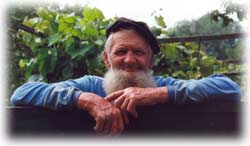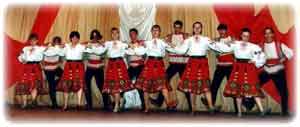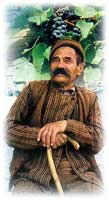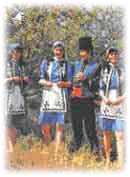

INTRODUCTION | HISTORY | CULTURE | NATURE | ALIVE DELTA | LOCAL CUISINE
![]()
 Photogallery of Reni and Reni district. Get acquainted wit the town sights!
Photogallery of Reni and Reni district. Get acquainted wit the town sights!
![]()
 Companies offering tourist services in the town of Izmail.
Companies offering tourist services in the town of Izmail.
![]()
 In this section you would find the info on tourist itineraries and the description of the complex of services offered.
In this section you would find the info on tourist itineraries and the description of the complex of services offered.
Lower Danube region is extremely interesting in its multinational culture. The representatives of more than 40 nationalities live here side by side for a long time. Some of them have lived here for centuries; some came here 200-300 years ago.
On visiting the Lower Danube, you have an opportunity to get acquainted with a bright multinational culture of Bessarabia, to listen to the national songs, to join in their dances and to taste various sorts of sunny Southern wines. The most representative ethnic groups of Bessarabia are Russians, Ukrainians, Moldavians, Bulgarians and Gagauziens; in the pre-war time here also resided large German and Jewish communities.
![]() UKRAINIANS
UKRAINIANS
 Already in the XIXth century Ukrainians became a numerous ethnic group of the area. Throughout the centuries, Ukrainians have been farmers. Besides, they are talented fishermen, gardeners, floriculturists - you cannot imagine the Ukrainian farmstead without a beautifully arranged garden and a vineyard.
Already in the XIXth century Ukrainians became a numerous ethnic group of the area. Throughout the centuries, Ukrainians have been farmers. Besides, they are talented fishermen, gardeners, floriculturists - you cannot imagine the Ukrainian farmstead without a beautifully arranged garden and a vineyard.
Throughout the centuries of their history Ukrainians have been inborn corn-growers. Besides, they are talented market-gardeners, fishermen, farmers, gardeners, floriculturists - you cannot imagine the Ukrainian farmstead without a garden being not well-groomed and a vineyard being not smothered in flowers and greenery. The icon was an obligatory object for the Ukrainian house to be in. Icons appeared in Ukraine as long ago as back to the Xth century after the Rus had been christened.
A special place on the Ukrainian menu is given to “salo”, “vareniki” and “borsch”. More about these traditional dishes you can find at Local Cuisine.
National Ukrainian garments are bright and colorful, decorated with embroideries and cross-stitching. The Ukrainian ethnical community, although mixed with Russian and Moldavian cultures, has preserved its original national features.
![]() RUSSIANS
RUSSIANS
 The first Russians came to the Lower Danube in the 18th century. These first Russians were called old-believers. Old-believers or “lipovans” resisted the innovations in the Russian Orthodox Church introduced by Patriarch Nikon in the 17th century. Trying to fervently preserve their Orthodox faith, they fled to the Lower Danube and founded the first settlements of Zhourilovka, Verhny and Nizhny Dounaets, later followed by Staraya Nekrasovka and Lipovanskoe.
The first Russians came to the Lower Danube in the 18th century. These first Russians were called old-believers. Old-believers or “lipovans” resisted the innovations in the Russian Orthodox Church introduced by Patriarch Nikon in the 17th century. Trying to fervently preserve their Orthodox faith, they fled to the Lower Danube and founded the first settlements of Zhourilovka, Verhny and Nizhny Dounaets, later followed by Staraya Nekrasovka and Lipovanskoe.
Clothing and footwear of Lower Danube old believers retained many classical Russian features. Traditional clothing include “kosovorotka” (a Russian male shirt with a collar fastening at the shoulder side), “armiak” (peasant’s coat of heavy cloth), and “sarafan” (Russian female sleeveless dress). Local footwear, made of reed mace, - ”papuryanki” remind Russian “lapti”. As of today production of “papuryanki” still remains a traditional handicraft.
The cuisine of old believers has almost lost such typically Russian dishes as “shchi” (cabbage soup), “okroshka” (cold kvass soup) and “tyurya” (soup of bread and water). Old believers enjoyed Ukrainian “borsch” (beetroot and cabbage soup) which eventually replaced “shchi”. Fish remains to be a special dish on the menu of old believers.
A lot of family names of the first settlers have been imprinted on the maps of the Lower Danube region - islands, arms, channels, bays, coves and sandy spits.
![]() MOLDOVANS
MOLDOVANS
 The written history documents first mention Moldovans in the Xth century, referring to them as “vlakhs” or “volokhs”. The Moldovans settled on the southern banks of the Danube.
The written history documents first mention Moldovans in the Xth century, referring to them as “vlakhs” or “volokhs”. The Moldovans settled on the southern banks of the Danube.
Historically Moldovans of the Lower Danube were one of the poorest ethnic groups. Men toiled a lot in the fields, in the vineyard and looked after the cattle. A Moldavian woman was in charge of the entire household.
“Mamalyga” (porridge made out of maze dough) was everyday bread for Moldovans. They ate it with sour cream, melted butter, fried eggs, cracklings and “brynza” (sheep’s milk cheese - feta cheeze), and they drank with it fresh and sour milk. During large festive parties Moldovans combined dishes of Ukrainian, Moldavian, Russian and Jewish cuisines. “Borsch” on a fat duck boulion was considered the most luxurious dish, and it symbolized the income level of a family.
One of the most favorite ways of spending leisure time was dancing to the drums’ and accordion’s music. Dances were held at a special place selected for that purpose - “la colts” - at the corner. That was not only a place for dancing, but also a popular spot where young girls and lads could meet.
![]() BULGARIANS
BULGARIANS
 The first Bulgarians appeared in the Lower Danube in the beginning of the XIXth century. All Bulgarian migrations to Bessarabia were connected with Russian-Turkish wars.
The first Bulgarians appeared in the Lower Danube in the beginning of the XIXth century. All Bulgarian migrations to Bessarabia were connected with Russian-Turkish wars.
Bulgarians built their houses out of adobe, using traditional planning; walls of the rooms were decorated with silk homespun towels.
Although corn-growing was a traditional activity for Bulgarians, the new settlers found it first difficult to adapt it to severe steppe conditions. However, with time corn-growing, together with gardening and vine-growing, became especially developed. Bulgarians were and still are brilliant shepherds; sheep are well adapted to the steppe climate.
Traditional Bulgarian cuisine includes a big variety of vegetables, cereals and mutton, lavishly seasoned with spicy red pepper. Traditional “gyuvetch’” (vegetables baked in a small pot) is made of sweet pepper, egg-plants, onions, carrots and tomatoes. “Mandzhya” (vegetable ragout) is popular not only with Bulgarians; today it is a combined meat vegetable dish - stewed meat with potatoes in thick sauce with pepper.
Family is the foundation of the local Bulgarian community. A marriage issue was approached with a big responsibility. Trying to find a match for their son or daughter, parents paid attention not only to the moral and ethical qualities of the young people, but would also notice how hard-working and thrifty they were. It was not really always the case that the parents of the young people would agree on the marriage of their children. Young people sometimes protested against that and would “steal” the bride, having agreed with her on that before.
Bulgarians married their sons and daughters off very early. Parents would begin preparing for the wedding party long before, especially the bride’s parents. Even several years before the wedding party actually took place; the mother of the bride would start preparing the dowry for her daughter: she would spin yarn, weave and embroider. The daughters were also involved in the preparation. The wedding party would last for a whole week, each day having its own ceremony to be observed.
![]() GAGAUZIENS
GAGAUZIENS
 Gagauziens belong to an original Turkic-speaking ethnic group, however, professing Orthodox Christianity. The name of this people originates from old Ogouz tribes that led a nomadic life in the Eurasian steppes.
Gagauziens belong to an original Turkic-speaking ethnic group, however, professing Orthodox Christianity. The name of this people originates from old Ogouz tribes that led a nomadic life in the Eurasian steppes.
Gagauziens are hereditary cattle-breeders, who on coming to Ukraine and Moldova became involved into vine- and corn-growing. They are also occupied with farming, growing mostly cereals. In Gagauzien villages they bake some bread products out of wheat dough: “yekmek” (bread), “geouzlemya” (soft shortbread in which “brynza” (sheep’s milk cheese) is wrapped up) and “kabakly pidya” (grated pumpkin with sugar baked in dough). Among other popular dishes there are “mandzhya” (vegetable ragout) and “gyuvetch’” (vegetables baked inside a small pot). Especially popular and delicious are “kavarma” (stewed mutton with a lot of red pepper added to), “piynir” (salty sheep cheese) and “brynza” (sheep’s milk cheese).
Gagauziens kept big family traditions for a long time. The oldest man was the head of such family. He owned all the property. He would leave it as an inheritance to his youngest son, not to the elder one. The youngest one would have to care about his parents until they died; he couldn’t marry until his elder brothers got married. Gagauzien approached the matter of choosing wife or husband very seriously. They got married early, at the age of 16-18 years. Among the wedding ceremonies they had there was a special one used to initiate the young people into the family life - they were given a “test” and seriously examined to see if they had the knowledge and skills necessary for the family life.
Daughters after they got married went to live in their husbands’ places. Though the role of the woman in the family was big, her rights were considerably limited. She had no right to break into men’s conversations, and being in the presence of some other men she had to keep silent at all. When husband and wife were going somewhere together, he would obligatory walk ahead of her.
NAVIGATION: HOME PAGE >> ABOUT LOWER DANUBE >> CULTURE
Design, support: IncomSoft © 2003-2013 >Gassib-ug